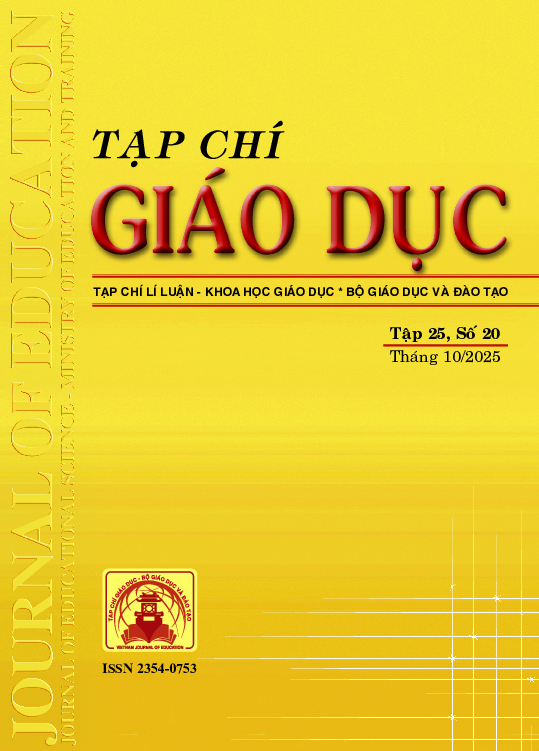Sử dụng các kết nối toán học trong dạy học khái niệm “nguyên hàm” (Toán 12)
Tóm tắt
Mathematics provides theoretical knowledge and requires logical thinking, creativity and the ability to connect concepts. In teaching, establishing relationships between concepts, processes and practical applications plays an important role, creating a foundation for mathematical connections. Antiderivative is an important content in the 12th grade Mathematics program, often causing difficulties for students due to their abstract nature. Students struggle to understand the nature of antiderivatives, the relationship with derivatives and practical applications. Integrating mathematical connections into teaching the concept of “Antiderivative” aims to help students overcome these difficulties, improve logical thinking and creativity. The study proposes a process for teaching Mathematics through mathematical connections and illustrates this process through teaching the concept of “Antiderivative”. Teaching Mathematics based on mathematical connections can stimulate initiative, create students’ learning motivation with realistic situations, in connection with science, technology or other fields; thereby contributing to improving teaching effectiveness and developing students' mathematical competences.
Tài liệu tham khảo
Boaler, J. (1998). Open and closed mathematics: Student experiences and understanding. Journal for Research in Mathematics Education, 29(1), 41-59. https://doi.org/10.5951/jresematheduc.29.1.0041
Bressoud, D. (2019). Calculus reordered: A history of the big ideas. Princeton University Press.
Eli, J., Schroeder, M. J., & Lee, C. W. (2013). Mathematical connections and their relationship to mathematics knowledge for teaching geometry. School Science and Mathematics, 113(3), 120-134. https://doi.org/10.1111/ssm.12009
Gürbüz, R., & Erdem, M. (2019). The role of mathematical connections in problem-solving: A case study in calculus. Educational Studies in Mathematics, 101(2), 135-150. https://doi.org/10.1007/s10649-019-09894-6
Hiebert, J., & Carpenter, T. P. (1992). Learning and teaching with understanding. In D. A. Grouws (Ed.), Handbook of Research on Mathematics Teaching and Learning (pp. 65-97). Macmillan.
National Council of Teachers of Mathematics (NCTM, 2000). Principles and standards for school mathematics.
Nguyễn Dương Hoàng, Phan Anh Tuấn (2024). Dạy học chủ đề ba đường conic Toán 10 theo định hướng kết nối toán học với thực tiễn. Tạp chí Khoa học, Trường Đại học Đồng Tháp, 13(01S), 54-64. https://doi.org/10.52714/dthu.13.01S.2024.1300
Nguyễn Thị Tân An, Lê Văn Vũ (2024). Kết nối toán học giữa đạo hàm và tích phân trong dạy học giải quyết các vấn đề thực tế. Tạp chí Giáo dục, 24(10), 12-17.
Pambudi, D. S., Budayasa, I. K., & Lukito, A. (2020). The role of mathematical connections in mathematical problem solving. Jurnal Pendidikan Matematika, 14(2), 129-144. https://doi.org/10.22342/jpm.14.2.10985.129-144
Stewart, J. (2015). Calculus: Early transcendentals (8th ed.). Cengage Learning.
Suh, J. M., & Seshaiyer, P. (2017). Mathematical connections and student understanding of mathematical concepts. Journal of Mathematical Behavior, 45, 97-114. https://doi.org/10.1016/j.jmathb.2016.11.001
Trần Nam Dũng, Trần Nam Dũng (tổng chủ biên), Trần Đức Huyên (chủ biên), Nguyễn Thành Anh (chủ biên), Vũ Như Thư Hương, Ngô Hoàng Long, Phạm Hoàng Quân, Phạm Thị Thu Thủy (2023). Toán 12 (tập 2 - Bộ sách Chân trời sáng tạo). NXB Giáo dục Việt Nam.
Tải xuống
Đã Xuất bản
Cách trích dẫn
Số
Chuyên mục
Giấy phép

Tác phẩm này được cấp phép theo Ghi nhận tác giả của Creative Commons Giấy phép quốc tế 4.0 .












